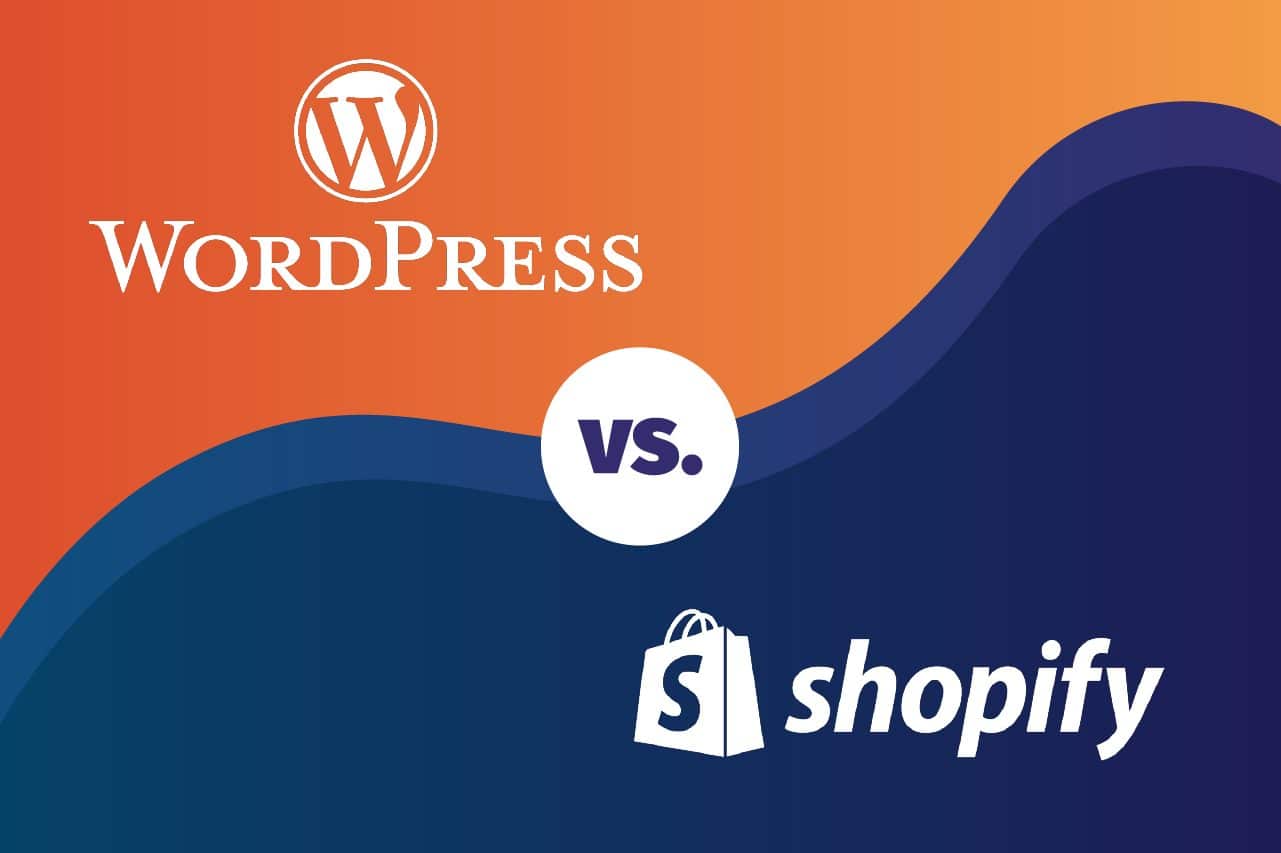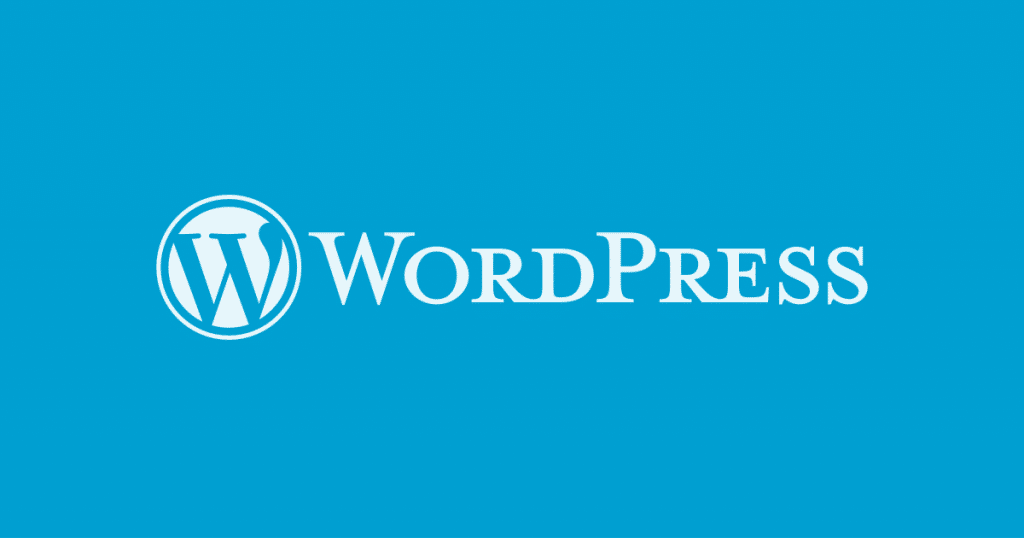
Whether you’re just starting out in the world of e-commerce or you’re thinking of revamping your current website, you might be wondering which platform to house your website’s design.
Is WordPress or Shopify the best option for your business?
With e-commerce set to hit around 5 trillion dollars in sales by 2021, it’s not a bad time to throw your hat in the ring. But in order to get the most out of this surge in online shopping, you need a website that highlights your products and helps you reach your business goals.
If you’re toggling back and forth between WordPress and Shopify, there are several factors that will dictate which direction will be best for you. Let’s dive into both platforms further and see what they each have to offer for an e-commerce business.
e-Commerce on WordPress

WordPress is an exceedingly popular all-in-one content management system used to build out fairly detailed, customized websites. About 25% of all websites are powered by WordPress. Technically, this platform isn’t predisposed to support an online shop. But you can still make modifications to accommodate one. In order to create an e-commerce site, you must install additional plugins (such as WooCommerce) and make other adjustments from there.
When WordPress first launched, it was a platform to build blogs, which sparked a huge trend at the beginning of the century. Now, the WordPress community has built a variety of templates and plugins to help any business operate directly from the platform.
How Much Does it Cost to Use WordPress?
WordPress is free software. But the price tag can rack up quickly once you factor in the cost of your domain name, hosting, and any premium themes or plugins. There are a lot of factors that play into how much you’ll spend so it’s difficult to give a definitive price range. Some sites might cost somewhere in the low hundreds while others can creep up to the tens of thousands.
This is dependent upon who you hire to build your website and what you want to do with the website. As an open-source platform, the sky’s the limit when working with WordPress. A well-learned and educated developer can easily manipulate the code of the template to create essentially anything you want. But, if you have an e-commerce site with hundreds of products and you want to run it similar to an e-commerce giant like Amazon, you’re likely to spend more in the upper thousands.
Remember, you’ll be obligated to pay a yearly fee for your domain and hosting too. This cost is outside of your web design and development costs.
How to Set Up Your WordPress Site
Setting up a WordPress site can be quite a time-consuming endeavor. There are several steps to getting your site up and running. And there are some additional steps to creating an e-commerce WordPress site. Here’s a general breakdown of the process.
- First things first, you’ll need to buy a domain and secure a web hosting account. Your domain will be your future web address. Domain prices start at around $10 per year but this can easily be higher since it all depends on the demand for the domain name. Once you have a domain, find a hosting provider. There are a variety of options ranging from shared to private. Pricing will depend on what service you decide to go with.
- Next, you’ll need to install WordPress. You can do this through a one-click or manual method. If you want to do the one-click method, you’ll either have to get your domain and hosting services from the same source or buy hosting from a source trusted by WordPress. Manual installation is more advanced. This requires you to set up a server manually.
- Now that your site is installed, it’s time to pick out a theme (design) and pick an e-commerce plugin. You can do both of these things in the WordPress backend (dashboard). The most popular option is WooCommerce. But there are a couple of other options including Easy Digital Downloads and WP eCommerce. Log in to your backend and click “Plugins” on the left-hand sidebar. Click “Add New”, search for your preferred e-commerce plugin, and select “Install Now”.
- Now it’s time to set up your product pages. Each e-commerce plugin will require a different process to get your product pages live. But, generally, you’ll be required to title your products, create engaging captions, and use high-quality, optimized images.
- Last but certainly not least, you’ll need to decide on a payment gateway. This is the real meat and potatoes of any e-commerce site. There are quite a few options to choose from here too. Some popular ones include Stripe, PayPal Payments Standard, and Simplify Commerce. The payment gateway will allow customers to use the payment function so they can actually order off your website. You’ll have to set up a bank account to transfer the funds through the payment gateway. This isn’t the easiest process, so contact a developer if you need assistance.
e-Commerce on Shopify

Shopify was built specifically for e-commerce website builds. The whole purpose of each website template on Shopify is to create an optimal user experience in the buyer’s journey.
If you’re one with limited technical expertise as far as website building goes, Shopify could be a good option for you. It allows a business owner to get their e-commerce site up and running with little to no web design experience necessary. This all-in-one website-building software offers a no-fuss option to create an attractive e-commerce site without any complicated steps or coding.
However, if you want a website that is less templated and more custom, Shopify web design is quite a hassle since it uses Liquid coding language, which is different from any other web-building platform.
How Much Does it Cost to Use Shopify?
The pricing structure of Shopify is a lot more straightforward than WordPress. Shopify offers five different pricing plans each with its own set of benefits and e-commerce tools. These plans will vary based on store management options, shipping, and point of sale. Here’s a basic breakdown of how Shopify prices its plans:
- Lite: $9 monthly
- Basic: $29 monthly
- Shopify: $79 month
- Advanced: $299 monthly
- Plus: Starts at $2000 per month (but is negotiable)
How to Set Up Your Shopify Site
Setting up your site is a bit more intuitive than WordPress too. Since it’s tailored towards business people with little web-building experience, you can get your site live in a snap. Simply follow these nine steps to get your e-commerce shop off the ground.
- First, start a free trial of Shopify. This is when you’ll pick a title for your default URL (root domain). It will be presented as “storename.myshopify.com”. Later on, you can buy a custom domain without “myshopify.com” tagged at the end.
- Now it’s time to build the meat of your e-commerce site. Once you finish setting up your account, you’ll need to add the products you want to sell. Simply go to the left-hand sidebar on the backend (dashboard) of your website and select Products > Add product. Now you can build out your product listings with a title, photos, a description, the price, and more.
- Aside from hosting your products, your site also does the important work of building a rapport with your clientele. That means creating other key pages for your site. You can do this by going to Online Store > Pages on the left-hand sidebar on the backend of your website.
- Once you have the basic structure of your site fleshed out it’s time to pick a theme and customize your online store. Shopify has hundreds of themes to pick from so you’ll be sure to find a look that will match the feel of your business.
- A vital aspect of any online store is how you’ll handle getting your products to the customer. The next order of business when setting up your site is customizing your shipping settings. This is where you’ll decide on a shipping strategy such as free shipping, flat rate, or local pickup.
- To remain in accordance with your local government, you’ll need to collect taxes from each purchase made in your online shop. The next step in setting up your site will be to configure your tax settings. Shopify makes this process easy but remember to consult a tax professional if you have any complex questions.
- Just like WordPress, you’ll have some options when it comes time to set up your payment gateway and payout options. Here you can decide if you want to include any one-click options such as Shop Pay, offer sales in multiple currencies, establish your payout schedule and more.
- And just like that, you have a fully realized e-commerce site! But before you go live, be sure to prepare your store for its launch. Some of the last pieces of housekeeping are adding a custom domain, installing relevant sales channels, customizing your notification settings if you’d like to, and setting up store tracking and analytics.
- Voila! Now all there is left to do is launch your online store! Shopify makes it fairly easy to make adjustments as you need to and they also offer 24/7 support via phone, email, or live chat if you happen to have bugs that need fixing.
Which is Best for E-Commerce?
To be honest, there is no definitive answer to that question. WordPress and Shopify are both top-tier options for an e-commerce site. But each offers something slightly different for you as a business owner. The best fit for you and your unique needs will depend on how much you’re willing to spend, how customizable you would like your site to be, and, overall, what your business goals are.
Let’s break down the difference between these two e-commerce options and see where they shine or fall short. In this section, we’ll go through some of the features you might consider while planning out a website.
Inventory Management
As a business owner, you’re well aware of the importance of keeping track of your progress and making sure your inventory is in order. It’s vital to have a good understanding of how this works on your e-commerce site or you could end up with incorrect numbers and a muddled image of how your business is doing.
When comparing WordPress and Shopify in this department, Shopify takes the cake for ease of use. Since it is a dedicated e-commerce software, they offer built-in inventory management features as well as other e-commerce tools such as multi-channel integration and abandoned cart recovery. WordPress can also accommodate such features but you’ll need to go through third-party plugins which could become complex for an inexperienced web builder.
The Best For Inventory Management: Shopify gives you a streamlined look at your inventory. Everything is neatly organized in one spot making it easy for occupied business people to keep an eye on their books.
Transactions
Another major facet of any e-commerce site is transaction functionality. Your customers will be looking for an intuitive, easy way to check out once they decide to buy goods from you. There are a lot of options out there and you want to be sure your site has a reliable, secure transaction process your customers will appreciate.
Shopify lets you choose between 100 different payment gateways. They support all the popular options such as PayPal, Stripe, Amazon Pay, and Apple Pay. If you become a Shopify Partner you won’t need to pay additional transaction fees but any other plan will include fees.
As we’ve discussed, you’ll need to install plugins to add payment gateways to your WordPress site. Most of the e-commerce plugins support a majority of the popular options. You won’t have any additional transaction fees through WooCommerce, Ecwid, or WP eCommerce.
The Best For Transactions: Too close to call. Shopify offers more payment gateways to choose from but WordPress doesn’t tack on extra fees. The best one for you will depend on your priorities.
Maintenance
Once you set up a website you’ll need to periodically keep up with maintenance. Both Shopify and WordPress will need an update from time to time. Shopify carries out updates automatically. WordPress, on the other hand, can be a little more complex. Since your WordPress e-commerce site consists of software, plugins, and themes from different sources, they’ll all be due for updates at different times. This can mean more frequent maintenance for the site owner.
The Best for Maintenance: When it comes to ease of use, Shopify takes the cake for the best maintenance. If you’re already busy keeping up with your burgeoning business, you most likely don’t want to put much effort into maintaining your site.
Content Management
Aside from managing your products, your website should exemplify your company values and give your customers a chance to further learn more about you and your industry. That means maintaining a blog, posting additional content, and generally keeping your website as a living document.
WordPress is primarily a content management system. Getting up a blog is quite easy on its interface. Generally, the process is to create content on the backend, preview it, and post it. Shopify has a similar process. But with WordPress, you can install plugins to craft content on a visual building. You also get more control over the layout on WordPress.
The Best for Content Management: WordPress is the king of content. If you want to build quality content for your e-commerce site, this will be your best option.
SEO
SEO –or search engine optimization– is an important part of any online marketing plan. Essentially, it is a strategized effort aimed towards positioning your website higher on search engine results pages. This can be done through keyword optimization, lowering page load time, building out relevant content, and more.
You can incorporate SEO practices on both WordPress and Shopify. You might not be surprised to hear that you need to install a plugin called Yoast SEO to get the most out of your SEO efforts on WordPress. Shopify has many SEO tools already built into its interface. Through the backend of your site, you access helpful apps such as SEO Audit Pro, SEO Image Optimizer, and SEO Booster for free.
The Best for SEO: Although WordPress makes it fairly easy to incorporate SEO into your site maintenance routine, the ease of Shopify gives it a slight advantage. However, it will all come down to the apps you choose to implement SEO strategies. When it comes to e-commerce SEO, we recommend Shopify.
Choose the Platform You’ll Stay With
We want to be clear that both WordPress and Shopify are great options for building out e-commerce websites. But we also want to point out that you should really take the time to consider your best option and the option you’ll stick with for years to come.
Here’s why:
We’ve worked with website migrations on the often. This is the process of moving a website from one platform to another. In terms of keeping your website’s health and strength high during a migration, switching from one platform’s structure over to Shopify can prove challenging.
The main issue is Shopify’s closed-minded software. Essentially, Shopify only wants you to use Shopify the way they created it, without deviating from the structure. Migrating a website over to Shopify means you have to deal with a strict permalink structure. This is the URL structure used for every page. Shopify automatically creates a path that is meant to keep things organized. This looks something like this:
/pages/
/blogs/
/products/
/collections/
You might think that this is really great, except when it comes to transferring and redirecting pages. WordPress allows you to take authority over your permalink structure. You don’t have to have a path within the URL of an individual page. With WordPress, this is a choice. But on Shopify, you don’t have a say.
This also isn’t the most efficient way to build your SEO. While many SEO professionals will agree that including a path in a URL is a smart idea, it’s best if you can organize it the way you want instead of being left without a choice.
So, if you are planning on migrating your website to another platform in the future, think about the impact of the permalink structure. Google indexes your website’s pages based on the URL. If it finds a 4XX page error, that damages your website’s health and strength, which then affects your ranking in organic search. This is when you’ll have to create a redirect for every single page that has a new URL on the new platform.
Choose your platform very carefully.
TL;DR
When it comes to selecting the best e-commerce option for you, you’ll need to decide what you want to prioritize.
Shopify has a lot of perks for a business owner with no site-building experience. It offers an abundance of tools for easy maintenance and gives you tons of themes to choose from. It’s a great avenue for someone just dipping their toes into e-commerce.
WordPress can be a bit more work to get up and running but it can be worth your while once you do. WordPress is a lot more customizable and there are way more options as far as content creation goes.
At the end of the day, these are both excellent candidates for your e-commerce website.
Get A Professional to Help
Whether you decide to go with WordPress, Shopify, or a completely different platform, the process of building and maintaining a website can be tedious, to say the least. If you’re in over your head when it comes to building an effective e-commerce website, it may be time to hand the reins over to the pros. Not to worry! Beyond Blue Media is here for any and all of your web development needs.


